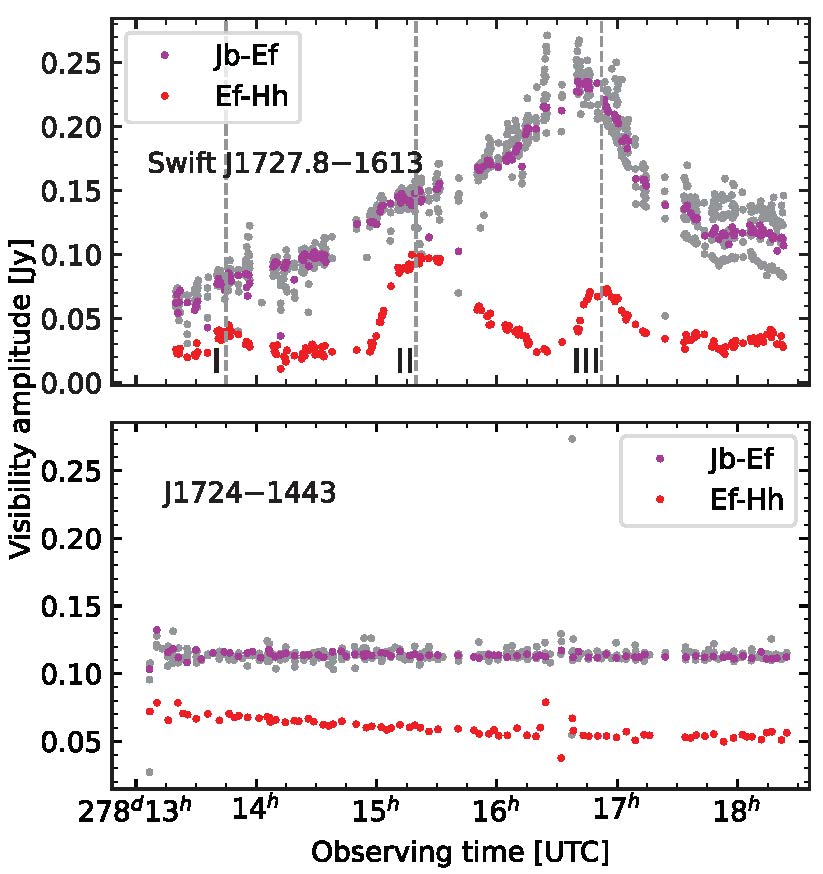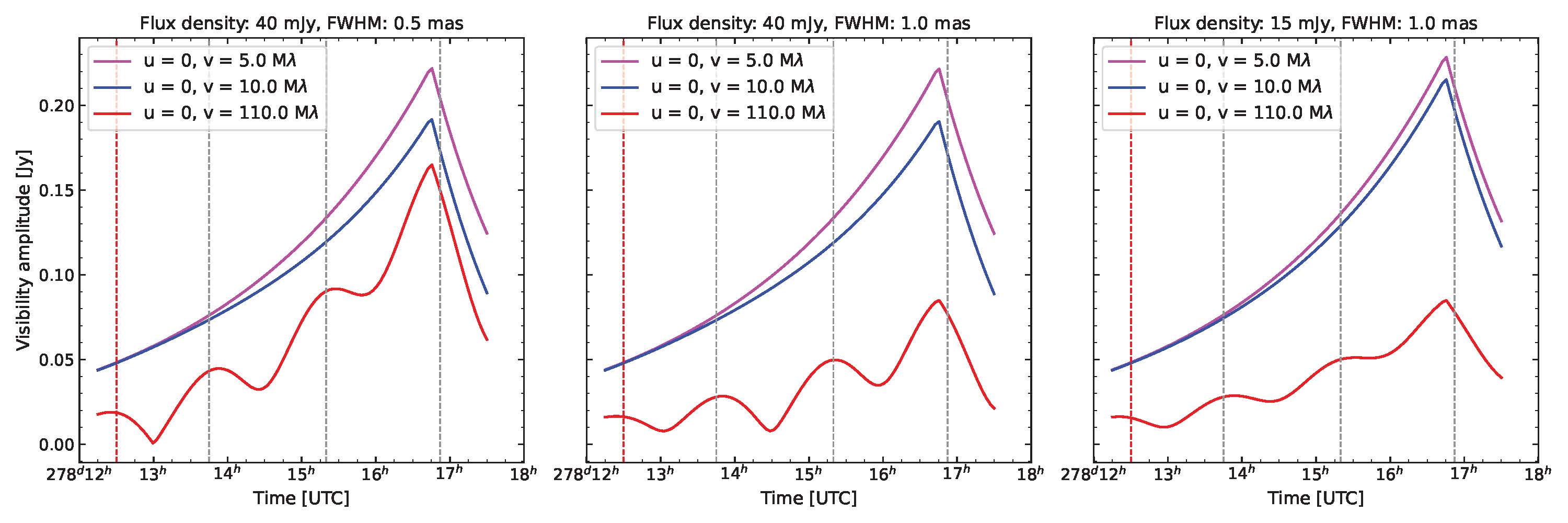
An ejection event captured by the EVN during the outburst of a Galactic black hole low-mass X-ray binary: Swift J1727.8–1613
Hongmin Cao
A low-mass black hole X-ray binary is a system in which the primary object, i.e., a stellar-mass black hole, is accreting material via Roche-lobe overflow from its companion star, which is a low-mass (<1 M☉) main-sequence or evolved star. Such systems exhibit a fairly regular pattern of state evolution when they occasionally enter an outburst state, triggered by thermal-viscosity instabilities in the accretion disk. During an outburst, the system typically evolves from the low-hard state (LHS) to the high-soft state (HSS) via the hard-intermediate state (HIM) and short-lived soft-intermediate state (SIM), and then returns to the LHS via a low-luminosity intermediate state. A compact jet is always observed in the LHS and HIM, while around the state transition from HIM to SIM, a transient jet, i.e., ejection of relativistic plasma blobs, is typically observed. Transient jet can also occur in the HIM.
On August 24, 2023, a new X-ray transient (Swift J1727.8–1613) was discovered by Swift/BAT (Page et al. 2023). MAXI monitoring revealed it to be extraordinarily bright, with the maximum X-ray flux reaching approximately 7 Crab in the 2-20 keV band on August 29, 2023. Rapid follow-up optical spectroscopy and radio observations classified the source as a Galactic black hole X-ray binary candidate. An EVN target-of-opportunity (ToO) observation was promptly requested in September 2023. This ToO experiment, lasting 6 hr, was carried out on October 5, 2023, immediately following a radio quenching event observed by the VLA (Miller-Jones et al. 2023), as well as a drop in the fractional rms variability and the disappearance of type-C QPO in the NICER observations (Bollemeijer et al. 2023), suggesting a possible state transition from the hard-intermediate state to the soft-intermediate state.

Figure 1. Visibility amplitude vs. observing time. The three vertical dashed lines in the upper panel indicate the approximate peak positions of the visibility amplitudes of Swift J1727.8–1613 on the Hh baselines (red curve). For the convenience of display, the plot is made with the baselines to the most sensitive Ef antenna, and only one IF (IF 5 at 4.927 GHz) is shown, with the data points further averaged over every 15 visibilities. The amplitudes measured on the Jb–Ef baseline are highlighted with magenta, and data points on baselines between Ef and other European antennas are shown in gray. For comparison, the lower panel shows the nearly constant visibility amplitudes measured for the compact phase-reference calibrator quasar J1724–1443.
As shown in Figure 1, the visibility amplitudes on the European baselines first rise and then fall, suggesting that the source underwent a large-amplitude variability. The visibility amplitudes overlap before the peak and then diverge toward the end of the observation, indicating that the source was initially unresolved but then became tentatively resolved by the European baselines. The visibility amplitudes on baselines between Hartbeesthoek and Europe exhibit a beating pattern, implying that the source was resolved on these longer baselines aligned in the south-north direction. This is consistent with the prominent jet extending to the south detected by the VLBA (Wood et el. 2024), carried out before the EVN experiment. This beating characteristic, together with the flux-density variability revealed by the European baselines, is fully consistent with a plasma-blob ejection event, either a single blob ejected from the core or two oppositely directed blobs moving away from the core. In both cases, the approaching blob is expected to dominate due to Doppler boosting effect. From the average baseline length of the baselines between Hartbeesthoek and the European antennas (d = 110 M𝝺) and the time interval between the two adjacent peaks (t = 1.5 hr; see Figure 1) seen on the Hartbeesthoek baselines, the apparent separation angular speed of two components is calculated as approximately 30 mas/day.

Figure 2. The simulated evolution of the visibility amplitude over time. The amplitudes at three points in the visibility plane, i.e., (0, 5) M𝝺, (0, 10) M𝝺, and (0, 110) M𝝺, are selected to represent two short baselines and one long baseline. The model consists of two components. The flux density of the stationary component and the FWHM diameter of the moving component are 40 mJy and 0.5 mas for the left panel, 40 mJy and 1.0 mas for the middle panel, and 15 mJy and 1.0 mas for the right panel, respectively. The start time of the EVN observation is indicated by the vertical red dashed line. The three vertical gray dashed lines are the same as those in Figure 1.
Figure 2 shows a simulation of the case where a single blob is ejected from the radio core. In this simulation, the size of the core is fixed at a FWHM of 1.0 mas, and the blob moves to the south at an angular speed of 30 mas/day. The total flux density of the two components follows the evolution of the visibility amplitudes on the short baseline Jb–Ef (see Figure 1). It is clear that the visibility amplitudes first rise and then decline on the short baselines, while exhibiting a beating pattern on the long baseline. The three panels of Figure 2 indicate that a decaying core in flux density, together with a continuously expanding blob during the ejection event, can explain the data as shown in Figure 1.
The black hole nature of the primary star was confirmed by Mata Sánchez et al. 2025, which also measured a source distance of 3.4 kpc. Assuming the approaching blob is dominant, the estimated angular separation speed by VLBI (30mas/day), together with the source view angle (30–50°) constrained by the X-ray polarization observations (Svoboda et al. 2024), allows to estimate the magnetic field strength of 0.4–0.5 G in the rest frame of the blob, and its kinetic power of 10³³ erg/s. The latter appears to be much lower than the accretion power (defined as Ṁc², Ṁ is the accretion rate and c is the light speed) of 10³⁹ erg/s, estimated from the X-ray flux monitoring by MAXI.
The VLBI experiment took place in the rising phase of an even larger 4-day-long radio flare, implying that such ejection events were quite frequent. The High-level hard X-ray flux (>0.5 Crab at the 10–20 keV band) suggests that the inner hot disk was not completely collapsed, indicating that the source was still in the hard intermediate state.
Transient jets are closely related to dramatic changes in the disk–corona structure, and they are notoriously difficult to capture due to their unpredictable and short-lived nature. Nearly continuous X-ray flux and timing monitoring by low-Earth-orbit X-ray satellites offers opportunities to identify these phemonena, and the (triggered) follow-up multi-wavelength, high-cadence observations are necessary for fully understanding their physical mechanisms. In this regard, bright X-ray transient sources, like Swift J1727.8–1613, are especially valuable.
The VLBI results were recently published in The Astronomical Journal Letters (Cao et al. 2025).
References:
Bollemeijer, N., Uttley, P., Buisson, D., et al. 2023, ATel, 16273, 1
Cao, H.-M., Yang, J., Frey, S., Wood, C. M., Miller-Jones, J. C. A., Gabányi, K. É., Migliori, G., Giroletti, M., Cui, L., An, T., Hong, X.-Y., Wang, W.-H., 2025, ApJL, 987, L14
Miller-Jones, J. C. A., Bahramian, A., Altamirano, D., et al. 2023a, ATel, 16271, 1
Mata Sánchez, D., Torres, M. A. P., Casares, J., et al. 2025, A&A, 693, A129
Page, K. L., Dichiara, S., Gropp, J. D., et al. 2023, GCN, 34537, 1
Svoboda, J., Dovčiak, M., Steiner, J. F., et al. 2024, ApJL, 966, L35
Wood, C. M., Miller-Jones, J. C. A., Bahramian, A., et al. 2024, ApJL, 971, L9
Link to the paper:
Hongmin Cao et al 2025 ApJL 987 L14
Contact:
Hongmin Cao, Shangqiu Normal University, China. Email: hongmin.cao@foxmail.com
Jun Yang, Onsala Space Observatory, Sweden. Email: jun.yang@chalmers.se